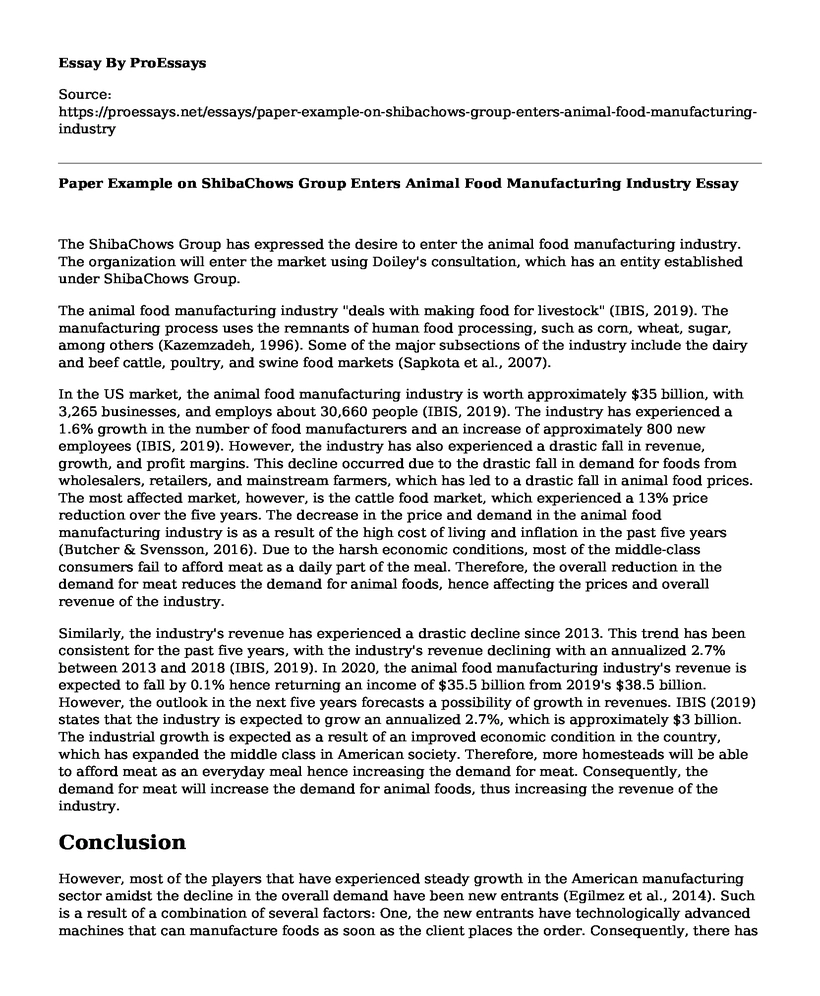The ShibaChows Group has expressed the desire to enter the animal food manufacturing industry. The organization will enter the market using Doiley's consultation, which has an entity established under ShibaChows Group.
The animal food manufacturing industry "deals with making food for livestock" (IBIS, 2019). The manufacturing process uses the remnants of human food processing, such as corn, wheat, sugar, among others (Kazemzadeh, 1996). Some of the major subsections of the industry include the dairy and beef cattle, poultry, and swine food markets (Sapkota et al., 2007).
In the US market, the animal food manufacturing industry is worth approximately $35 billion, with 3,265 businesses, and employs about 30,660 people (IBIS, 2019). The industry has experienced a 1.6% growth in the number of food manufacturers and an increase of approximately 800 new employees (IBIS, 2019). However, the industry has also experienced a drastic fall in revenue, growth, and profit margins. This decline occurred due to the drastic fall in demand for foods from wholesalers, retailers, and mainstream farmers, which has led to a drastic fall in animal food prices. The most affected market, however, is the cattle food market, which experienced a 13% price reduction over the five years. The decrease in the price and demand in the animal food manufacturing industry is as a result of the high cost of living and inflation in the past five years (Butcher & Svensson, 2016). Due to the harsh economic conditions, most of the middle-class consumers fail to afford meat as a daily part of the meal. Therefore, the overall reduction in the demand for meat reduces the demand for animal foods, hence affecting the prices and overall revenue of the industry.
Similarly, the industry's revenue has experienced a drastic decline since 2013. This trend has been consistent for the past five years, with the industry's revenue declining with an annualized 2.7% between 2013 and 2018 (IBIS, 2019). In 2020, the animal food manufacturing industry's revenue is expected to fall by 0.1% hence returning an income of $35.5 billion from 2019's $38.5 billion. However, the outlook in the next five years forecasts a possibility of growth in revenues. IBIS (2019) states that the industry is expected to grow an annualized 2.7%, which is approximately $3 billion. The industrial growth is expected as a result of an improved economic condition in the country, which has expanded the middle class in American society. Therefore, more homesteads will be able to afford meat as an everyday meal hence increasing the demand for meat. Consequently, the demand for meat will increase the demand for animal foods, thus increasing the revenue of the industry.
Conclusion
However, most of the players that have experienced steady growth in the American manufacturing sector amidst the decline in the overall demand have been new entrants (Egilmez et al., 2014). Such is a result of a combination of several factors: One, the new entrants have technologically advanced machines that can manufacture foods as soon as the client places the order. Consequently, there has been a reduction in the overall cost of storage and inventory management (Silbergeld, Graham & Price, 2008). On the other hand, the new entrants' model of advertisement targets modern farmers, mostly millennials, hence using cost-effective marketing such as social media. Similarly, most of the new entrants are packaging the foods upon the customers' request. Therefore, this means that the customers can collect the foods using their recycled bags or using other means such as an open truck. Such is evident that animal food manufacturing is price sensitive and responds positively to dynamic business models (Kazemzadeh, 1996).
References
Butcher, C., & Svensson, I. (2016). Manufacturing dissent: Modernization and the onset of major nonviolent resistance campaigns. Journal of Conflict Resolution, 60(2), 311-339.
Egilmez, G., Kucukvar, M., Tatari, O., & Bhutta, M. K. S. (2014). Supply chain sustainability assessment of the US food manufacturing sectors: A lifecycle-based frontier approach. Resources, Conservation and Recycling, 82, 8-20.
IBIS World, (2019). Farm Animal Food Production Industry in the US - Market Research Report. Retrieved from: https://www.ibisworld.com/united-states/market-research-reports/farm-animal-food-production-industry/
Kazemzadeh, M. (1996). US Patent No. 5,587,193. Washington, DC: US Patent and Trademark Office.
Silbergeld, E. K., Graham, J., & Price, L. B. (2008). Industrial food animal production, antimicrobial resistance, and human health. Annu. Rev. Public Health, 29, 151-169.
Cite this page
Paper Example on ShibaChows Group Enters Animal Food Manufacturing Industry. (2023, Jun 11). Retrieved from https://proessays.net/essays/paper-example-on-shibachows-group-enters-animal-food-manufacturing-industry
If you are the original author of this essay and no longer wish to have it published on the ProEssays website, please click below to request its removal:
- Oil Market in UAE Analysis Essay
- Microeconomic Analysis Paper for Apple Inc
- Organizational Changes on Samsung and Apple Example
- Essay Sample on British Petroleum Oil Spill Disaster: 5 Million Barrels of Oil in the Gulf of Mexico
- Essay Example on Space Challenger Disaster: Engineers' Ethical Failure.
- Global Natural Gas Demand: Price & Income Elasticities Analysis - Essay Sample
- Free Paper Example: Amazon's Resilience in European Business







